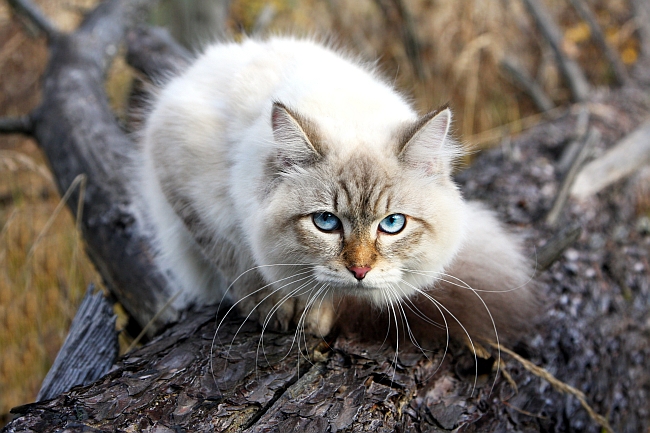Most cat owners (wisely) keep their kitties as indoor pets, especially when winter weather sets in and the temperatures start to drop. But even the lucky felines curled up against the radiator or next to the fire fare better than others, depending on their coat length and breeding. Glance at the below list to find out which breeds do well in winter, and which do not!

Maine Coon: Famed as America’s largest cat breed, the Maine Coon seems almost designed for snowy grounds and frosty winds. Their thick fur is almost cloak-like, and is water-resistant in texture. Their long bushy tails reach around their paws and faces when exposed, providing extra coverage and insulation from the cold. The Maine Coon’s wide paws allow them to maneuver swiftly and silently over freshly fallen snow, acting almost as a snow shoe. For cat owners living in icy areas, this affectionate breed is a fantastic pet.

Scottish Fold: All Scottish Fold cats originated from one hardy barn cat who lived in the wilds of the Scottish Highlands. Her descendants have dense short coats, or long fluffy coats, with the recognizable ears that fold over against their heads, holding in their body heat. If this breed can stand the unforgiving Scottish winters, they would be comfortable and any frigid climate.

Siberian Cats: This landrace cat hails from the Siberian region of Russia, which is one of the colder parts of the world. The Siberian Forest Cat (which is its official title) is also considered by many to be partially hypoallergenic despite its long fur, because these creatures excrete less Fel d1 than other cats.

Norwegian Forest Cats: Like its Russian counterpart mentioned above, the Norwegian Forest Cat is one of the larger cat breeds. Their under coats provide insulation, and the long coats have a glossy, coarse texture which repels water, making this breed a great companion for wet, rainy or snowy climates. The Norwegian Forest Cat has been mentioned in Norse folklore to be a mountain-climbing cat, active and adept even in the dead of winter.

Ragdolls: The silky hair of the Ragdoll provides ample body heat in cooler weather. Though these are a more relaxed, less energetic breed than other cats (whose energy keeps their blood pumping in the winter!), the Ragdoll still fares well because of their luxuriant long coat.

Russian Blue: Though the Russian Blue is different from the long-haired breeds on this list, they are still may be counted among other cats who thrive in chilly regions. Though their fur appears short, it is two layers thick, with a soft dense coat under the surface, and a silvery shiny coat on the outer level.

Himalayan cats: Since the tallest mountain on earth is located in the Himalayas, the very name of this cat breed suggests its adaptability to high altitudes and low temperatures. The Himalayan cat’s coat is so thick and heavy, it makes them appear almost pillow-like. Though this breed competes in fancier shows as a separate entity, most breeders believe these cats (as well as the Exotic Shorthair cats) to be a very close variations of the Persian breed.

Persian cats: With their familiar smug face features and lazy tendencies, it can be hard to imagine the Persian as a cat suitable for harsh weather and cold countries. However, they have double layered coats that enable them to be comfortable in wintertime. That said, you can hardly expect to find your Persian willing to set foot on icy ground if he doesn’t have to. These pampered cats prefer to lounge inside where it is warm, thank you very much!
Note: Cats that do not cope with cold climates without the help of a winter pet jacket, is the hairless Sphynx, as well as single coated pets such as the Devon Rex, and the Peterbald cat.

